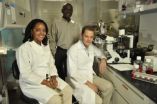Too many Facebook friends bad news for charities
2012-08-06
(Press-News.org) New research suggests the more friends we have on Facebook, the less likely we are to share information about charitable causes.
Economist Professor Kimberley Scharf, from the Centre for Competitive Advantage in the Global Economy (CAGE) at the University of Warwick, claims when we have larger online social networks, we rely on other people to pass on information about opportunities to give. This phenomenon is called 'free riding'.
Professor Scharf also suggests we may even rely on others to donate. She will present her research paper 'Private Provision of Public Goods and Information Diffusion in Social Groups' in Dresden at the 2012 International Institute of Public Finance Congress on 16-19th August.
In the paper, she develops an economic model of giving where people share overlapping social neighbours.
Professor Scharf said: "For example, with Facebook I have friends and my friends have friends. I wanted to see if the number of social connections individuals have affects the way that information about quality of charity provision is diffused, and if it does, what the implications are for total giving.
"Information transmission about giving opportunities is undermined by 'free riding' incentives – I count on other neighbours to convey information and so save on the effort of doing it myself. If there is less information flowing about who are the more effective charities, then not all donations will be going to the best performing charity and there will be a reduction in the charitable good or service. As well as relying on others to pass on information, it may also be true that people are even relying on others to donate."
Professor Scharf said her study showed there is more giving in smaller, closer-knit groups of individuals who share common interests.
She said: "This is what matters, the closeness of social interactions: large loosely connected groups share information less effectively than smaller, better integrated groups.
"Economists have traditionally viewed giving as an individual choice. It is time for a rethink – we are long overdue in asking questions about how social connections shape giving. The answers are important, they will help us understand how better to target private and public resources aimed at promoting giving."
Professor Scharf added social interactions are not always good for giving. People may share information about worthy causes or good providers, but if there are too many people sharing information, the messages could get lost in the noise of the crowd.
###
Notes to editors
The paper 'Private provision of public goods and information diffusion in social groups' by Kimberley Scharf is published as a CAGE working paper (http://www2.warwick.ac.uk/fac/soc/economics/research/centres/cage/research/papers/kim_working_paper.pdf) and as a CEPR Discussion Paper 8607 (http://www.cepr.org/pubs/new-dps/dplist.asp?dpno=8607.asp).
To speak to Professor Scharf, please call (+44) 07800 961 216, k.scharf@warwick.ac.uk or alternatively contact Kelly Parkes-Harrison, Press and Communications Manager, k.e.parkes@warwick.ac.uk, 02476 150868, 07824 540863
ELSE PRESS RELEASES FROM THIS DATE:
2012-08-06
A fundamental characteristic of quantum physics is the fact that two or more particles can exhibit correlations stronger than classically allowed. This unique characteristic applies particularly to quantum entanglement: as soon as the quantum state of a particle is measured the state of its entangled partner changes accordingly, regardless of how far apart the two entangled particles might be. This feature allows for the remote quantum state preparation, which is an essential ingredient for applications in quantum communication, quantum cryptography, and quantum computation.
The ...
2012-08-06
A UNC-led team of scientists describes the function of a previously uncharacterized protein that dramatically influences inflammation.
A majority of the NLR family of proteins function as activators of inflammation. However, scientists at UNC report that a newly identified NLR protein, NLRC3, was able to inhibit a major inflammatory pathway that is controlled by a protein called NF-Kappa B. NF-Kappa B activation has been long associated with inflammation and cancer promotion. Their article appears in the August 5,2012 online publication of the journal Nature Immunology. ...
2012-08-06
VIDEO:
This visualization shows a flat map of the Earth with summertime temperature anomalies for the Northern Hemisphere. This analysis compares observed seasonal mean temperatures (June-July-August) to the seasonal mean temperatures...
Click here for more information.
A new statistical analysis by NASA scientists has found that Earth's land areas have become much more likely to experience an extreme summer heat wave than they were in the middle of the 20th century. The research ...
2012-08-06
News outlets need to be held to account for their coverage of the English riots, a new report has argued.
Media and the Riots: A Call for Action, published today on the first anniversary of the riots, is the first report to examine the impact of the mainstream print and broadcast media's reporting on the communities most affected.
The report, written by Dr Leah Bassel of the University of Leicester's Department of Sociology, reflects the views of those who attended the Media and the Riots conference held by the Citizen Journalism Educational Trust and citizen journalism ...
2012-08-06
Philadelphia, PA, August 6, 2012 – Vaginal delivery for early preterm fetuses presenting head first, or vertex presentation, had a high rate of success with no difference in neonatal mortality compared to cesarean delivery, a new study published in the American Journal of Obstetrics and Gynecology reports. For breech births, however, the failure rate of vaginal delivery was high and planned cesarean delivery was associated with significantly lower neonatal mortality.
"Selecting a route of delivery at less than 32 weeks' gestation is a difficult clinical decision given ...
2012-08-06
Patterns in nature are in everything from ocean currents to a flower's petal.
Scientists are taking a new look at Earth patterns, studying the biodiversity of yard plants in the U.S. and that of desert mammals in Israel, studying where flowers and bees live on the Tibetan plateau and how willow trees in America's Midwest make use of water.
They're finding that ecology, the study of relationships between living organisms and their environment, and phylogenetics, research on evolutionary relationships among groups of organisms, are inextricably intertwined.
Results ...
2012-08-06
WASHINGTON, Aug. 6, 2012—Inspired by the erratic behavior of photons zooming around and bouncing off objects and walls inside a room, researchers from the Massachusetts Institute of Technology (MIT), Harvard University, the University of Wisconsin, and Rice University combined these bouncing photons with advanced optics to enable them to "see" what's hidden around the corner. This technique, described in a paper published today in the Optical Society's (OSA (http://www.osa.org)) open-access journal Optics Express (http://www.opticsinfobase.org/oe), may one day prove invaluable ...
2012-08-06
Two proteins that act in opposing directions – one that promotes cancer and one that suppresses cancer — regulate the same set of genes in prostate cancer, Vanderbilt-Ingram Cancer Center researchers have found.
The findings, reported recently in the Journal of Clinical Investigation, point toward potential drug targets and prognostic markers for prostate cancer.
"We are trying to understand the molecular genetics of prostate cancer: what are the genes that are altered in human prostate cancer, and very importantly, how do they lead to cancer when they are changed?" ...
2012-08-06
SYRACUSE. N.Y, August 6, 2012 – Tree cover in the nation's Lower 48 states covers 659 million acres, more than one-third of the nation, according to a U.S. Forest Service study of national tree cover and impervious surfaces. New Hampshire leads the nation in percent tree cover (89 percent), followed by Maine (83 percent) and Vermont (82 percent). On the other end of the spectrum, North Dakota has the lowest percent tree cover (3 percent), followed by Nebraska (4 percent) and South Dakota (6 percent).
Using aerial photograph interpretation of circa 2005 imagery, U.S. ...
2012-08-06
MANHATTAN, KAN. -- A commercial vaccine for cattle can effectively reduce levels of E. coli by more than 50 percent, a Kansas State University study has found. The vaccine is also effective using two doses instead of the recommended three doses, which can help cut costs for the beef industry.
David Renter, associate professor of epidemiology, is the principal investigator on a project that researched the effectiveness of products used to prevent the shedding of E. coli O157:H7 in cattle. The research appears in a recent online version of the journal Vaccine and helps ...
LAST 30 PRESS RELEASES:
[Press-News.org] Too many Facebook friends bad news for charities



